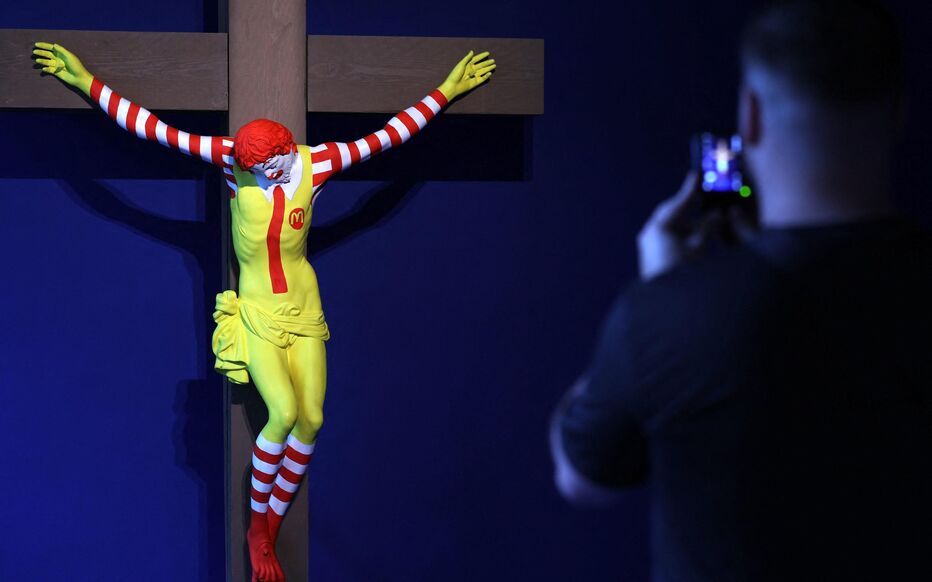
The Museum of Forbidden Art in Barcelona: a museum where creative freedom defies censorship

On 26 October 2023, a revolutionary museum opened its doors in Barcelona, marking the advent of the very first museum dedicated to censored works. Called the "Museum of Forbidden Art", this unique establishment brings together almost 200 works of art that have been censored in the name of religion, morality or for political reasons.
As you enter this captivating museum, you are immediately greeted by a papier-mâché man dressed in a grey mackintosh, wearing dark glasses and a thin moustache. Sitting on a chair with his hands on his knees, this "spectator of spectators" embodies both the agent of the political police and Franco's censor. This mannequin, created by the Valencian artists' collective Equipo Cronica in 1972, was intended to remind national and international artists and visitors that Spain was then subject to the moral, social and political control of an authoritarian regime. Today, one of these mannequins hangs in the museum's lobby, designed as a sanctuary for creative freedom, in opposition to censorship in all its forms.
The Museum of Forbidden Art is housed in the sumptuous Casa Garriga Nogues, a modernist palace built in 1900. Inside, a carefully chosen selection of almost 40 works by Spanish and international artists, mainly contemporary, is on display. Among the most striking pieces is the Lego portrait of Filippo Strozzi, son of a powerful Florentine Renaissance family, created by the Chinese dissident artist Ai Weiwei. Despite the Danish firm's refusal to supply him with the small bricks for his political works, Ai Weiwei produced this exceptional work. There is also a statue of Christ painted in the colours of Ronald McDonald, nicknamed "McJesus" and created by Finnish artist Jani Leinonen. This sculpture was attacked with smoke bombs by Christian opponents in a museum in Israel. The museum also features erotic drawings from Pablo Picasso's "347" series, as well as the scenes of misery and torture depicted in Francisco de Goya's "Caprichos". What all these works have in common is that they have been the victims of censorship, whether for political, religious or commercial reasons, social pressure or even violent attacks.

"McJesus", by Finnish artist Jani Leinonen, had caused Molotov cocktails to be thrown at the building in which it was exhibited in 2019. LLUIS GENE / AFP
The Museum of Forbidden Art is the fruit of the hard work of its founder, Spanish journalist and businessman Tatxo Benet. He has fully funded the museum's collection, which has been developed over the last five years. The museum does not cover the whole of art history, but focuses mainly on works from the 20th and 21st centuries. It examines the persistence and contemporary resurgence of issues of censorship and self-censorship. Among the iconic pieces on show are Andres Serrano's provocative "Piss Christ", which continues to provoke debate about blasphemy, and photographs by Robert Mapplethorpe, famous for his homoerotic and sometimes sadomasochistic male nudes from the 1970s and 1980s.
The collection also includes a work by the dissident Chinese artist Ai Weiwei, which LEGO deemed too political after refusing to supply the plastic bricks needed to make it. Visitors will also be able to see a nude portrait of former US President Donald Trump with a tiny penis, a work that earned artist Illma Gore threats of legal action, rejections from several galleries and even a physical assault. The collection also includes a work critical of the McDonald's restaurant chain by Yoshua Okón, which was withdrawn from a gallery in 2014, as well as drawings by Guantánamo prisoners. An exhibition of these drawings in 2017 prompted the US government to declare that no more works should leave the internment camp intact. Finally, visitors will be able to admire the installation "Silence Rouge et Bleu" by the Franco-Algerian artist Zoulikha Bouabdellah, combining thirty prayer rugs and as many pairs of high-heeled shoes. This installation was withdrawn from an exhibition in Clichy-la-Garenne in 2015 following complaints from Muslim associations.
The Museum of Forbidden Art offers a varied programme that its founder describes as "a triumph of freedom of expression" in an era marked by "cancel culture". In this age of pervasive censorship, this unique museum represents a haven of freedom for rebellious spirits, a place where forbidden art finally finds its place.
For more information on the Museum of Forbidden Art, visit their official website at www.museuartprohibit.org. Don't wait any longer, dive into this fascinating world where art defies censorship and celebrates creative freedom.
Credit: Zanele Muholi/Courtesy of the artist and Stevenson, Cape Town/Johannesburg and Yancey Richardson, New York.





































































